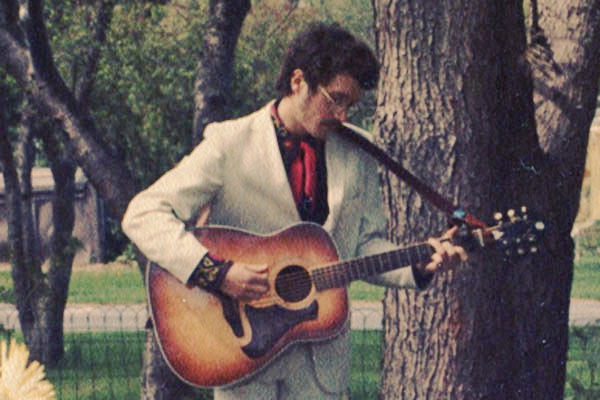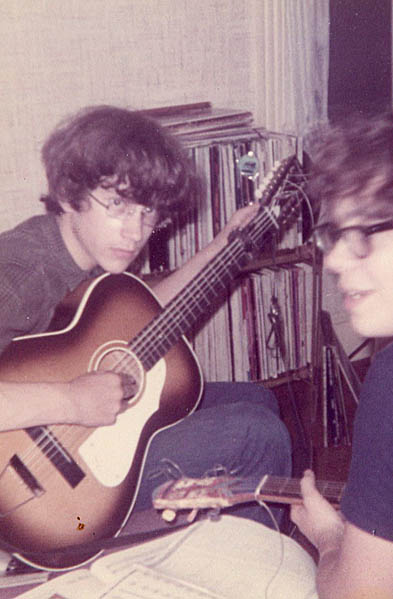Silvertones

Doug Hubley performs “Wild Horses” on the Silvertone 6-string at Nancy Hubley’s wedding, May 1975. Hubley Family photo.
Somewhere in Rwanda may still exist a Silvertone 6-string acoustic guitar that began its musical life in South Portland, Maine, with me.
My parents gave me the guitar for Christmas in 1971. I was 17. This guitar that became my close musical friend for the next 23 years was my second acoustic and second Silvertone, a brand carried by Sears, Roebuck & Co. and sold in the catalog.
The first Silvertone was a 12-string that I got in 1968, colored a dull brown sunburst seemingly inspired by Soviet design. This guitar would sound pretty good for the first week or so into a new set of strings, and then the tone subsided into a dull clang resembling a work party shoveling sand.
Worse than the sound was the action: The strings were so high that I kept them artificially depressed by tuning it low and routinely playing with a capo, advice I received from a 12-string how-to manual purportedly penned by Pete Seeger.
Hear the Silvertone 6-string in two songs written and recorded in summer 1973:
“For Tonight” and “Hamlin Square Song” copyright © 2010 by Douglas L. Hubley. All rights reserved.
The Lead Belly songs in the 12-string book gave me some valuable fundamentals, and it was nice chugging along with LB on something like “T.B. Blues.” But that guitar was essentially a dog, as I realized after a heavy flirtation with a friend’s Martin, and it was back to the Sears catalog for something better. (I sold the 12-string at a yard sale in 1978 for $8.)
The six-string wasn’t much better in the playability department (and again I resorted to detuning and the capo, which tended to flummox people I played with, who needed to be convinced that I was actually playing in the correct key). But it was pleasant to handle and had a decent sound, a dry tone that I still favor in an acoustic.

Doug Hubley and the Silvertone 12-string, left, with Tom Hansen and the Carmencita. Notice the capo that lived on the 12-string, and the cotton string that was the Carmencita’s strap. Hubley Family photo, 1969.
The fifth instrument in my arsenal, it quickly became my constant companion. It was on this guitar that I developed my acoustic style. A positive omen came with it too: Hippie that I was, I had stuck a round “skin jewel” on the 12-string that shone with a prism effect — and the new Silvertone came with a similar refracting reflector on it.
Not bad for a $48 guitar. And 1972 was a good year for a good cheap guitar: My first band had fallen apart during the winter, my love life was not thriving, I just was out of high school and into a job at a potato chip factory, and I was diving very deep into country music.
The Silvertone and I spent a lot time together. I didn’t own a car until I was 22, and before then got around by bicycle a lot. I appropriated some World War II vintage backpack webbing from my father and contrived a strap for the guitar case so I could carry it on my bike. In 1976, I brought the Silvertone to Europe: lined the case with foam rubber, coated it with fiberglass and attached a hasp for a padlock. It survived the trip fine.
So I guess I gave that guitar a taste for travel early on. I got a much better instrument in 1994 and the old Silvertone gathered dust for about a decade. Then a Rwandan student at the college where I work posted a want ad for an inexpensive guitar that she could send home to her boyfriend. The Silvertone filled the bill. I hope someone is still making music with it.
Text copyright © 2012 by Douglas L. Hubley. All rights reserved.